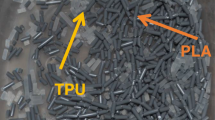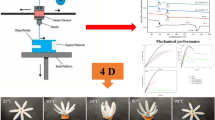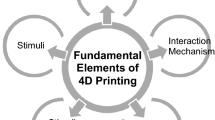Abstract
The fourth dimension in 4D printing refers to the ability of materials to alter its form after they are produced, thereby providing additional functional capabilities and performance-driven applications. Stimuli materials provide this capability through the use of shape memory polymers. For this research, the property of programming the determined shape is achieved through controlled heat under laboratory conditions. This paper shows the potential to process and experiment with thermoplastic polyurethane as a shape memory material. Taking a step further, we ascertain the properties of this material through extrusion-based additive manufacturing processes and produce parts for testing. The results show that the characteristics of the 3D printed parts successfully retain the property of the shape memory and the recovery force allows this to be utilised as a mechanical actuator. The recovery stress has been recorded to be between 0.45 and 0.61 MPa (at feed rate 990 mm/min). The maximum level of recovery stress is similar to the same material being processed through conventional compression moulding. Lastly, we designed and produced a coil as an actuator to demonstrate that the same material can be extended to other applications.
Similar content being viewed by others
References
Monzon MD, Ortega Z, Martínez A, Ortega F (2015) Standardization in additive manufacturing: activities carried out by international organizations and projects. Int J Adv Manuf Technol 76:1111–1121
ISO/ASTM (2015) ISO/ASTM 52900:2015 additive manufacturing—general principles—terminology
Huang SH, Liu P, Mokasdar A, Hou L (2013) Additive manufacturing and its societal impact: a literature review. Int J Adv Manuf Technol 67:1191–1203
Pei E (2014) 4D printing—revolution or fad? Assem Autom 34:123–127
Campbell TA, Tibbits S, Garrett B The next wave: 4D printing programming the material world. Atlantic council. http://www.atlanticcouncil.org/images/publications/The_Next_Wave_4D_Printing_Programming_the_Material_World.pdf. Accessed 4 Jan 2016
Pei E (2014) 4D printing: dawn of an emerging technology cycle. Assem Autom 34:310–314
Hu J, Zhu Y, Huang H, Lu J (2012) Recent advances in shape–memory polymers: structure, mechanism, functionality, modeling and applications. Prog Polym Sci 37:1720–1763
Yang WG, Lu H, Huang WM, Qi HQ, Wu XL, Sun KY (2014) Advanced shape memory technology to reshape product design, manufacturing and recycling. Polymers 6:2287–2308
**e T (2010) Tunable polymer multi-shape memory effect. Nature 464:267–270
Sun L, Huang WM, Wang CC, Zhao Y, Ding Z, Purnawali H (2011) Optimization of the shape memory effect in shape memory polymers. J Polym Sci A Polym Chem 49:3574–3581
Tobushi H, Hayashi S, Hoshio K, Ejiri Y (2008) Shape recovery and irrecoverable strain control in polyurethane shape-memory polymer. IOP Publishing Sci. Technol. Adv. Mater. http://iopscience.iop.org/article/10.1088/1468-6996/9/1/015009/pdf. Accessed 4 Jan 2016
Smith JL Material testing of shape memory polymers for modular robotics aplications and development of a prototype SMP gripper for mini-PR2 robot. NSF Summer Undergraduate Fellowship in Sensor Technologies. http://www.seas.upenn.edu/sunfest/docs/papers/SmithJennifer10.pdf. Accessed 4 Jan 2016
Ahmad M, Luo J, Miraftab M (2012) Feasibility study of polyurethane shape-memory polymer actuators for pressure bandage application. IOP Publishing Sci. Technol. Adv. Mater. http://iopscience.iop.org/article/10.1088/1468-6996/13/1/015006/meta. Accessed 4 Jan 2016
Ge Q, Dunn CK, Qi HJ, Dunn ML (2014) Active origami by 4D printing. IOP Publishing Smart Mater. Struct. http://iopscience.iop.org/0964-1726/23/9/094007/media. Accessed Jan 2016
Zarek M, Layani M, Cooperstein I, Sachyani E, Cohn D, Magdassi S (2015) 3D printing of shape memory polymers for flexible electronic devices. Adv. Mater. doi:10.1002/adma.201503132
Yang Y, Chen Y, Wei Y, Li Y (2015) 3D printing of shape memory polymer for functional part fabrication. Int J Adv Manuf Technol doi:10.1007/s00170-015-7843-2
Raasch J, Ivey JM, Aldrich D, Nobes DS, Ayranci C (2015) Characterization of polyurethane shape memory polymer processedby material extrusion additive manufacturing. Additive Manufacturing 8:132–141
Lendlein A, Kelch S (2002) Shape-memory polymers. Angew Chem, Int 41:2034–2057
Song JJ, Chang HH, Naguib HE (2015) Biocompatible shape memory polymer actuators with high force capabilities. Eur Polym J 67:186–198
Song JJ, Chang HH, Naguib HE (2014) Design and characterization of biocompatible shape memory polymer (SMP) blend foams with a dynamic porous structure. Polymer 56:82–92
Azra C, Plummer CJG, Manson JAE (2011) Isothermal recovery rates in shape memory polyurethanes. IOP Publishing Smart Mater. Struct. doi:10.1088/0964-1726/20/8/082002
Park H, Harrison P, Guoc Z, Leed MG, Yua WR (2016) Three-dimensional constitutive model for shape memory polymers using multiplicative decomposition of the deformation gradient and shape memory strains. Mech Mater 93:43–62
Author information
Authors and Affiliations
Corresponding author
Rights and permissions
About this article
Cite this article
Monzón, M.D., Paz, R., Pei, E. et al. 4D printing: processability and measurement of recovery force in shape memory polymers. Int J Adv Manuf Technol 89, 1827–1836 (2017). https://doi.org/10.1007/s00170-016-9233-9
Received:
Accepted:
Published:
Issue Date:
DOI: https://doi.org/10.1007/s00170-016-9233-9




